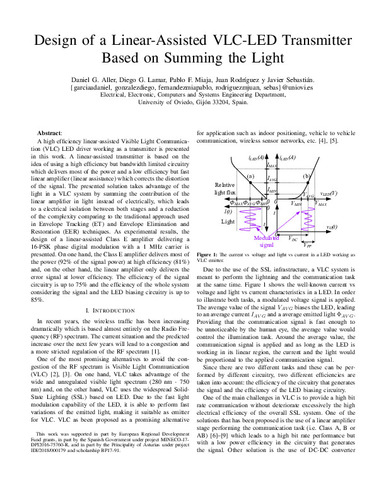Design of a Linear-Assisted VLC-LED Transmitter Based on Summing the Light
Fecha de publicación:
Editorial:
IEEE
Versión del editor:
Resumen:
A high efficiency linear-assisted Visible Light Communication (VLC) LED driver working as a transmitter is presented in this work. A linear-assisted transmitter is based on the idea of using a high efficiency but bandwidth limited circuitry which delivers most of the power and a low efficiency but fast linear amplifier (linear assistance) which corrects the distortion of the signal. The presented solution takes advantage of the light in a VLC system by summing the contribution of the linear amplifier in light instead of electrically, which leads to a electrical isolation between both stages and a reduction of the complexity comparing to the traditional approach used in Envelope Tracking (ET) and Envelope Elimination and Restoration (EER) techniques. As experimental results, the design of a linear-assisted Class E amplifier delivering a 16-PSK phase digital modulation with a 1 MHz carrier is presented. On one hand, the Class E amplifier delivers most of the power (92% of the signal power) at high efficiency (81%) and, on the other hand, the linear amplifier only delivers the error signal at lower efficiency. The efficiency of the signal circuitry is up to 75% and the efficiency of the whole system considering the signal and the LED biasing circuitry is up to 85%
A high efficiency linear-assisted Visible Light Communication (VLC) LED driver working as a transmitter is presented in this work. A linear-assisted transmitter is based on the idea of using a high efficiency but bandwidth limited circuitry which delivers most of the power and a low efficiency but fast linear amplifier (linear assistance) which corrects the distortion of the signal. The presented solution takes advantage of the light in a VLC system by summing the contribution of the linear amplifier in light instead of electrically, which leads to a electrical isolation between both stages and a reduction of the complexity comparing to the traditional approach used in Envelope Tracking (ET) and Envelope Elimination and Restoration (EER) techniques. As experimental results, the design of a linear-assisted Class E amplifier delivering a 16-PSK phase digital modulation with a 1 MHz carrier is presented. On one hand, the Class E amplifier delivers most of the power (92% of the signal power) at high efficiency (81%) and, on the other hand, the linear amplifier only delivers the error signal at lower efficiency. The efficiency of the signal circuitry is up to 75% and the efficiency of the whole system considering the signal and the LED biasing circuitry is up to 85%
Descripción:
Annual Conference of the IEEE Industrial Electronics Society (IES) (45th. 2019. Lisboa)
Patrocinado por:
This work was supported in part by European Regional Development Fund grants, in part by the Spanish Government under project MINECO-17- DPI2016-75760-R, and in part by the Principality of Asturias under project IDI/2018/000179 and scholarship BP17-91
Colecciones
Ficheros en el ítem




